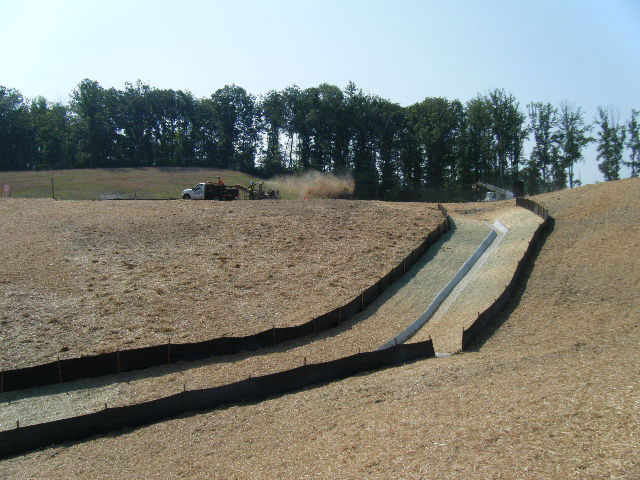Quality with Memphis Erosion Control Solutions hydroseeding
Wiki Article
Finest Practices for Disintegration Control in Construction Projects
Are you functioning on a building and construction project and worried regarding erosion control? In this article, we will lead you through the best methods for protecting against erosion on your site. silt fences. Obtain all set to deal with erosion head-on and make sure the success of your construction job.5 Necessary Erosion Control Strategies

To properly manage erosion on your building and construction site, you'll need to execute necessary techniques such as incline stablizing and debris control steps. Slope stabilization is important in preventing dirt erosion on steep inclines. Another efficient technique is the usage of erosion control blankets or floor coverings, which are positioned on the incline and assistance maintain dirt bits while enabling greenery to grow.
Reliable Sediment and Drainage Administration

You can properly manage sediment and drainage in your construction job by applying correct disintegration control steps. Sediment and runoff management is important to stop disintegration and safeguard the surrounding atmosphere. One effective step is the installation of silt fencings along the boundary of the construction website. These fences aid to include debris and avoid it from entering nearby water bodies. Another essential technique is the implementation of disintegration control coverings or floor coverings. These coverings provide a protective layer on bare soil, reducing the impact of rainfall and protecting against erosion. In addition, using debris containers or debris catches can aid to capture sediment and stop it from getting in stormwater systems. Normal upkeep of these actions is crucial to ensure their performance throughout the building and construction job. This consists of cleansing and checking sediment containers and routinely replacing silt fences and disintegration control blankets as required. By executing these disintegration control actions, you can successfully take care of debris and drainage in your building job, lessening the effect on the atmosphere and abiding with regulatory needs.
Key Considerations for Slope Stablizing
When thinking about incline stablizing, it's important to analyze the terrain and determine potential locations of instability. You need to thoroughly analyze the slope's features, such as its make-up, drainage, and angle patterns. Seek signs of disintegration, such as revealed roots, cracks, or down soil. These indicators can give you a concept of where stabilization steps may be necessary.When you have determined the unpredictable locations, you can begin carrying out procedures to maintain the slope. One usual approach is making use of retaining walls or terracing to produce a collection of flat steps, which can aid disperse the weight and protect against more disintegration. Another choice is to grow plants on the incline, as the roots can assist secure the soil and control erosion. Additionally, mounting disintegration control blankets or floor coverings can supply immediate protection while greenery becomes well established.
It's critical to on a regular basis keep track of the supported inclines to guarantee their performance. Keep an eye out for any type of helpful hints indicators of motion or erosion, and take prompt action if essential. Normal upkeep, such as inspecting and repairing any kind of damaged procedures, is additionally important to guarantee lasting stability.
Best Practices for Greenery and Dirt Defense
One reliable way to protect plants and soil on inclines is by regularly inspecting for signs of erosion and taking prompt action if essential. Start by checking the slope for any type of signs of disintegration, such as exposed origins, bare dirt patches, or debris accumulation at the base. Implement disintegration control steps such as setting up disintegration control blankets, mulching, or even creating preserving walls if needed.Applying Proper Drain Solutions
To effectively carry out correct drainage systems, it's important to take into consideration the incline gradient and soil type. When it pertains to taking care of water circulation and avoiding disintegration, recognizing these factors is vital. The slope gradient plays a considerable duty Full Article in establishing how water crosses the land. Steeper slopes can result in quicker water circulation, raising the threat of disintegration and flooding. On the various other hand, gentler slopes allow water to stream much more gradually, minimizing disintegration possibility. By evaluating the slope gradient, you can create an efficient water drainage system that accommodates the all-natural water movement.Sandy soils tend to drain faster due to their rugged appearance, while clay dirts have a slower water drainage price due to their compact nature. Furthermore, considering the dirt features assists stop waterlogging, which can lead to inadequate plant growth and damage to landscape projects structures.
Conclusion
In final thought, when it comes to erosion control in building and construction jobs, you should adhere to these ideal techniques. Think about slope stablizing approaches to make sure the stability of the website. By following these vital techniques, you can effectively manage disintegration and ensure the success of your building and construction job.To successfully control erosion on your construction website, you'll require to execute vital techniques such as slope stablizing and debris control actions. Slope stablizing is critical in avoiding soil disintegration on steep inclines. An additional efficient strategy is the use of erosion control coverings or floor coverings, which are positioned on the slope and help keep soil particles while allowing plants to expand. Another alternative is to plant plants on the slope, as the roots can aid anchor the soil and control disintegration. Implement disintegration control steps such as mounting disintegration control blankets, mulching, or also constructing retaining wall surfaces if required.
Report this wiki page